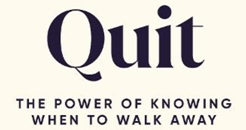 Knowing when to quit
Knowing when to quit
From an article by Behavioural Scientist
An incubator and developer of ideas called X, a subsidiary of Alphabet has a mission to build and launch technologies to “improve the lives of millions, even billions of people.”
They’re specifically in the business of identifying and accelerating world-changing ideas. That means they reject plenty of good ideas because the change those ideas create would be too incremental for their mission. One of X’s slogans is “10x impact on the world’s most intractable problems, not just 10% improvement.”
X has a very specific charter: to take their best ideas from concept to commercial viability in a five-to-ten-year time horizon. The reasoning behind the five-to-ten-year time horizon is that if the solution could be developed in fewer years, somebody else is probably already working on it. If it is going to take longer than a decade, the technology might be outdated by the time it gets to market.
To pursue radical ideas, they have to be a radical loss-cutter. They might start 1000 projects in a decade but only 4 might make it.
To help X-ers become better quitters, they have a unique mental model that has been woven into the fabric of X: monkeys and pedestals. Imagine that you’re trying to train a monkey to juggle flaming torches while standing on a pedestal in a public park. If you can achieve such an impressive spectacle, you’ve got a moneymaking act on your hands.
There are two pieces to becoming successful at this endeavour: training the monkey and building the pedestal. One piece of the puzzle presents a possibly intractable obstacle in the way of success. And the other is building the pedestal. People have been building pedestals for thousands of years. The bottleneck, the hard thing, is training a monkey to juggle flaming torches. The point of this mental model is to remind you that there is no point building the pedestal if you can’t train the monkey. In other words, you ought to tackle the hardest part of the problem first.
Pedestal-building creates the illusion of progress rather than actual progress itself. You are also accumulating sunk costs that make it hard to quit even as you find out that you may not be able to train the monkey to juggle those torches.
Butting up against a monkey that you can’t solve and turning to pedestal-building is a disaster on two fronts. Not only are you continuing to pour resources into something after the world is giving you signals that you won’t succeed, but those are resources you could be devoting to something better.
If we can identify in advance what the signals are that we should pay attention to and make a plan for how we will react to them, we can increase the chances that we’ll cut our losses when we ought to.
Essentially, when you enter into an endeavour, you want to imagine what you could find out that would tell you it’s no longer worth pursuing. Ask yourself, “What are the signs that, if I see them in the future, will cause me to exit the road I’m on? What could I learn about the state of the world or the state of myself that would change my commitment to this decision?”
That list offers you a set of criteria for killing a project or changing your mind or cutting your losses. It’s one of the best tools for helping you figure out when to quit. Kill criteria could consist of information you learn that tells you the monkey isn’t trainable or that you’re not sufficiently likely to reach your goal, or signs that luck has gone against you. The best quitting criteria combine two things: a state and a date in the form of “If I am (or am not) in a particular state at a particular date or at a particular time, then I have to quit.” Or “If I haven’t done X by Y (time), I’ll quit.” Or “If I haven’t achieved X by the time I’ve spent Y (amount in money, effort, time, or other resources), I should quit.”
X’s charter itself is an example of the interaction of states and dates. X’s projects must have the potential to be 10x world-changing (a state), capable of becoming commercially viable (a state), within five to ten years (a date). The monkeys-and-pedestals mental model and kill criteria help overcome an aversion to closing. The former naturally limits the losses that you have to absorb when you quit - the less you are down, the easier it is to walk away. The latter, set in advance, makes a pre-commitment to walk away when you see those signals, you are just more likely to follow through, even when you are losing.
X don’t always quit at the exact, right moment but they are always trying. They produce outsized returns and that turns out to be enormous.
Adapted from Quit: The Power of Knowing When to Walk Away by Annie Duke. This book draws on stories from elite athletes to Everest climbers, comedians to musicians and explains why learning to quit well is often crucial to success. The author provides clear strategies for working out when to cut your losses from a business product that isn't working, a relationship turned toxic, or a career that won't take you where you want to go. There are blocks to good quitting behaviour e.g., escalation commitment, desire for certainty and the status quo bias.
Read the full article here.
Retweet about this article:
From an article by Behavioural Scientist, 11/01/2023